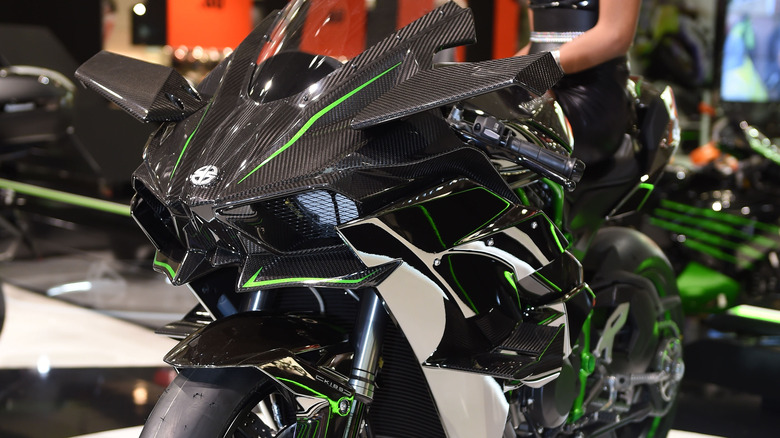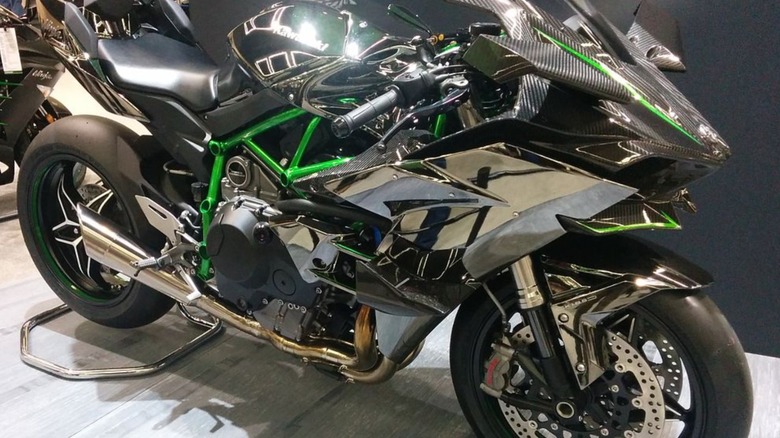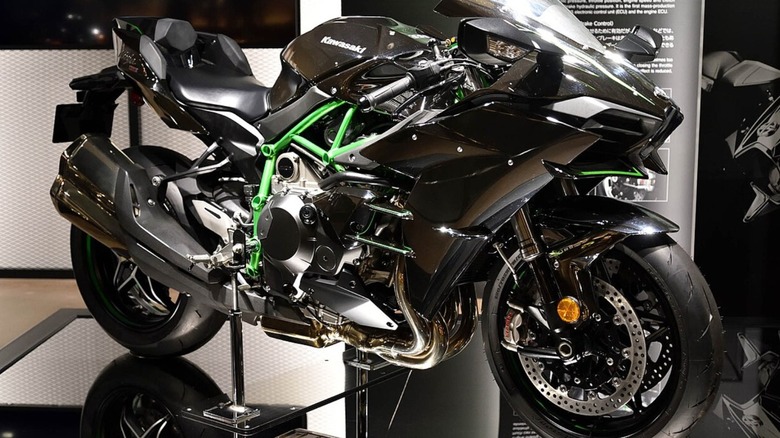Is Kawasaki's Ninja H2R Street Legal In The US? Everything You Need To Know
You won't see Max Verstappen barreling down the highway in Red Bull's RB20, as much of a spectacle as that would be. Why? Because it's safest when vehicles stay in their own milieu, and in environments they're equipped for. Roads, generally speaking, are for convenient and safe transport from A to B, which is why the rules of the road, particularly with regard to speed, can be so stringent.
As frustrating and costly as it always is to be on the receiving end of a speeding ticket, speed limits can be important factors in keeping drivers and passengers out of danger on the roads. The "gentleman's agreement" of late 1999 saw motorcycle companies unofficially agree to limit the speed of new road bikes to 186 mph. But it's not just speed that keeps racing machines confined to the tracks. Rules regarding emissions standards (such as the Clean Air Act), as well as noise emissions, and minimum equipment levels, are just some of the factors that can render a vehicle illegal to drive on public roads. The formidable Kawasaki Ninja H2R is a sports bike that, at a glance, makes you wonder if it could possibly ever be street legal.
Let's take a look at the legal regulations regarding this powerful machine, in state and federal terms, to determine why it's not legal for use on public roads.
Why the Kawasaki Ninja H2R isn't a street-legal bike
This monstrously speedy Kawasaki was designed specifically for racetrack use. As a result, it doesn't have the federally required lighting, such as headlamps, reflex reflectors, tail lamps, and turn signals (the latter are only unnecessary "on a motor driven cycle whose speed attainable in 1 mile is 30 mph or less" according to Federal Motor Vehicle Safety Standards), it would need for road travel. Nor does it feature mirrors on the upper cowl, features that are requirements in certain states. In Indiana, for example, a rearview mirror as well as turn signals and a speedometer are requirements for motorcycles released after January 1, 1956.
In terms of noise emissions, some states deem the H2R street-illegal on those grounds, too. Connecticut, for instance, limits motorcycles from 1979 onwards to 84 decibels when traveling at speeds above 35mph. Akrapovič reports that its Evolution Line exhaust for the H2R was developed to cut its roar down from 118 decibels — a level above the human pain threshold and comparable to a thunderclap — to a more reasonable 98 decibels in order to "make the Kawasaki Ninja H2R compliant with stringent decibel limits at some racetracks."
Those disappointed that the H2R isn't street legal in the US will be glad to hear that there's a variant that you can ride on the road. Additionally, it's possible to modify a H2R to comply with regulations.
[Image by Brianhe via Wikimedia Commons | Resized / CC BY-SA 4.0]
A toned-down yet still ferocious ride: The Kawasaki Ninja H2
The latest road legal version of this bike is the Kawasaki-made 2024 Ninja H2 ABS, which boasts 104.9 lb-ft of torque compared to the H2R ABS's 121.5 lb-ft. As far as horsepower goes, the ABS and Carbon 2024 H2s have 228 hp to the H2R's 328 hp.
The H2 doesn't feature the H2R's racing trim, and is road-legal straight from the factory. To ride any H2R onto the road in the United States, the bike will need to be heavily modified to bring it into line with state and federal rules.
This also applies elsewhere in the world: In 2019, the MadMax Race Team swapped the race exhaust for a decibel-reducing Akrapovič, and added components from the H2 such as brake lights and headlights, to make it street legal. Complying with UK decibel laws in this way cost a few horsepower, but the result was a 320 hp H2R that could legally speed along UK tracks and roads alike — a formidable streetfighter indeed.
[Image by Rikita via Wikimedia Commons | Resized / CC BY-SA 4.0]


